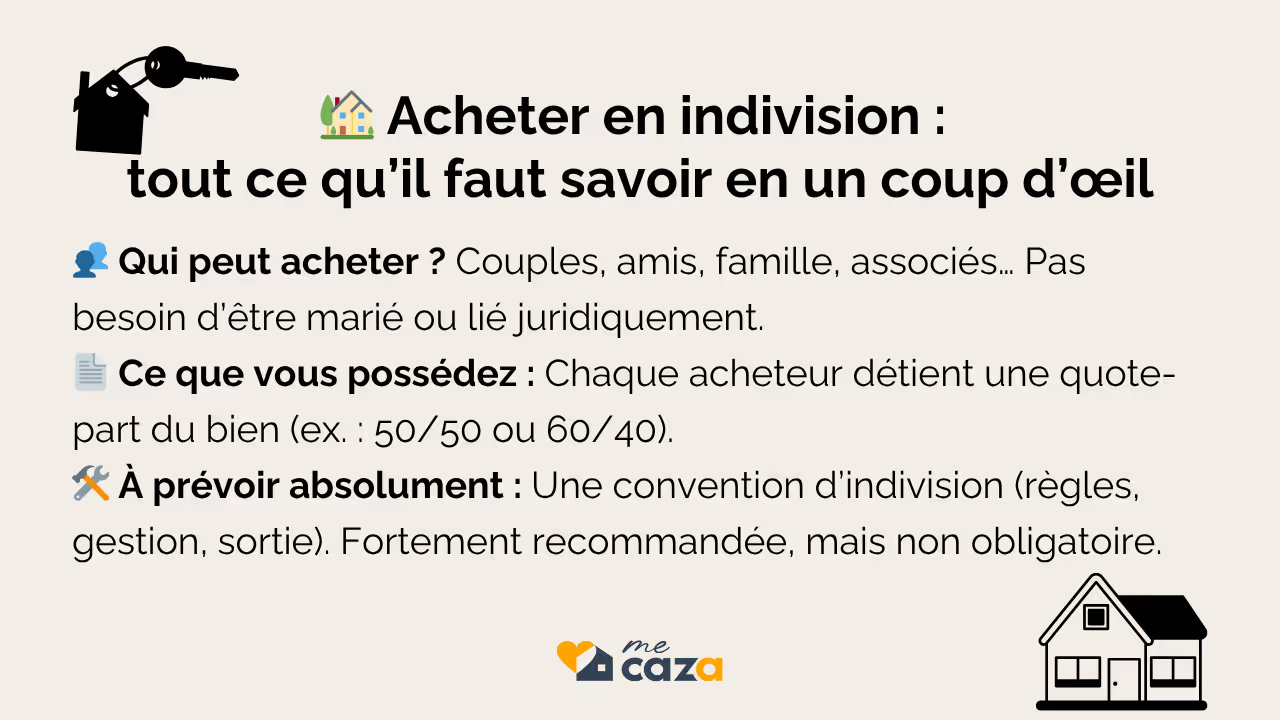Buying in joint ownership: Complete 2025 guide to buying with several people with complete peace of mind
Do you want to buy a property with several people without creating a company? Find out everything you need to know about buying jointly, its advantages, pitfalls to avoid and the keys to a successful project.
📅
10/7/2025

Buying real estate with several people may seem complex, butBuying in joint ownership offers a simple and flexible solution to make a common project a reality. Whether you are a couple, between friends or members of the same family, this method of acquisition allows you to share an investment while maintaining your respective shares.
However, this formula also includes specific rules, certain advantages... and risks that should not be overlooked.
In this comprehensive 2025 guide, you will discover everything you need to know about joint ownership: who can use it, how it works, how much it costs, what are the pitfalls to avoid, and why this buying method is attracting more and more French people.
🧾 What is joint ownership?
Real estate joint ownership is as intriguing as it is appealing. Before going into detail, let's see exactly what this method of buying involves from a legal and practical point of view.

Legal and legal definition
THEBuying in joint ownership is a legal form that allows several people to buy real estate together. Each buyer, called Undivided, owns a portion of the property expressed in Quota. Legally, this situation is governed by articles 815 and following of the French Civil Code.
This means that, even if the distribution is different (e.g. 60% for one and 40% for the other), all co-owners jointly own the property as a whole and not of a specific physical part.
The origin and typical situations of indivision
Indivision can come about in two ways:
- Voluntarily, during a joint real estate purchase (couples, friends, family members, associates...).
- By default, in particular as a result of a succession.
It is a simple, fast and economical solution to become an owner with several people without creating a company.
👥 ⚙️ Who can buy jointly?
Buying with several people is not just for a single profile. Let's explore the different categories of people who can use this solution.
Couples (married, in a civil partnership, cohabiting)
Unmarried couples or civil partnerships are often the first to be affected by joint ownership. Unlike couples married under the community regime, they must specify their respective shares in the act of purchase, otherwise everyone is deemed to be the owner in equal shares.
Friends, members of the same family
Two brothers, a mother and her daughter, a group of friends... Indivision allows everyone to pool resources to acquire a property that they would not have been able to afford alone.
Investors and associates
It is also a purchasing method used in real estate investment contexts. Two partners can buy a building or an apartment and then rent it out.
⚙️ How does joint ownership work?
Buying in joint ownership follows specific rules. Here is how shared ownership and living together around a property are concretely organized.
Distribution of shares (shares)
During the acquisition, notaries determine the Quotas based on the financial contributions of each. It is crucial to clearly indicate these shares in the notarial act to avoid any ambiguity.
Drafting an indivision agreement
Although not mandatory, the indivision agreement is highly recommended. It allows:
- To set management rules (maintenance, rental, resale...) ),
- To avoid conflicts,
- To give a clear framework to the relationship between co-owners.
Daily management of the property
Important decisions (sales, heavy work...) must be taken at Unanimity. On the other hand, acts of current administration can be decided by a 2/3 majority, if an agreement so provides.
🎯 Why choose to buy jointly?
Opting for this type of purchase can have many benefits. Let's look at the good reasons behind this choice.
Mutualization of the budget
This is the main advantage: buying together allows you to Raise more capital and therefore to access better quality goods.
Easy access to the property
Young working people or single-parent families find in indivision a Lever of home ownership without having to use a civil real estate company (SCI).
Fiscal and wealth interest
Indivision also offers management supple of assets and can allow fiscal optimizations (reduction of fees, cost sharing, etc.).
💰 How much does a joint ownership purchase cost?
The price of a property is not the only cost to take into account. Let's detail together the costs associated with this collective approach.
Notary fees and ancillary costs
Notary fees are identical to a classic purchase, calculated according to the total price of the property. However, each co-owner will pay prorated on his part.
Burden sharing and maintenance
Expenses related to maintenance, property tax or condominium fees are also distributed according to quotas.
Cost of an indivision agreement
Having a joint ownership agreement drawn up by a notary can cost between 500 and 1,500€, depending on the complexity of the case.
⚠️ What are the risks and disadvantages?
As advantageous as it may be, buying in joint ownership is not without danger. Here are the pitfalls to anticipate in order to avoid unpleasant surprises.
Conflicts between co-owners
One of the main disadvantages of buying in joint ownership is possibility of disagreements between the coindivisors. Whether it is about the use of the property, the carrying out of work or rental management, decisions often require a unanimous agreement, which can create tension.
Blocking in case of disagreement
Without a well-written joint ownership agreement, a simple disagreement can Block all management of the property. It is enough for a joint owner to oppose a decision to paralyse the real estate project, especially in the event of resale or major works.
Exit from joint ownership and forced sale
Each co-owner can, anytime, ask for the exit of the joint ownership. If no amicable agreement is reached, recourse to the court may lead to the Forced sale of the property, often at a price that is less than its real value.
🚪 How do you get out of an indivision?
The joint adventure may end one day. Let's discover the legal ways to end a joint venture, voluntarily or not.
Sale of the common property
The simplest solution is sale of the property with the agreement of all. The proceeds of the sale are then divided between the co-owners according to their share. This is often the preferred path when none of them wants to keep the property.
Repurchase of shares by a joint shareholder
One or more co-owners may decide to Buy back the shares of others. This makes it possible to avoid a sale on the market and to keep the property within the same person or family.
Recourse to the judge
In case of persistent disagreement, an undivided party may seize the Judicial court. The judge may order the auctions good or impose another exit solution. This process is often long and expensive.
📄 Shared ownership agreement: an essential tool?
This document is often the key to a smooth project. Focus on its content and its strategic interest.
What the convention should contain
The indivision agreement makes it possible to organize common life around the property. It may include:
- Decision-making rules,
- The management of expenses and rental income,
- The duration of the indivision,
- The fate of the property in the event of separation or death.
Duration and renewal
It can be concluded for a fixed term (up to 5 years, renewable) or undetermined. A well-written agreement Protect each co-owner and limits the risks of conflicts or blockages.
🔍 Comparison: indivision vs SCI (Société Civile Immobilière)
SCI or indivision? If you hesitate between the two, this comparison will help you to see more clearly according to your goals.
Advantages of SCI compared to joint ownership
La SCI offers more legal flexibility and fiscal. It allows:
- More fluid management (decisions are taken by the manager),
- Facilitated transmission of assets,
- Interesting fiscal arrangements (donations, dismemberment, etc.).
When to prefer SCI?
SCI is preferred when:
- The objective is rental investment or family transmission,
- The property is great value,
- Undivided co-owners want to anticipate conflicts or protect their heirs.
✅ Concrete examples of successful joint ventures
Let's talk concrete! Here are real situations where buying in joint ownership worked perfectly.
Testimonies from couples and families
Claire and Julien, in concubinage, bought an apartment in Paris jointly. Thanks to an agreement drawn up at the notary, they clearly established their shares (60/40) and the modalities in the event of separation. This prevented them from having any disputes when selling the property three years later.
Rental investment cases
Two brothers, investors, have acquired an investment building in Lyon in joint ownership. They have set up a structured joint management system with an agreement specifying the distribution of rents, expenses and the terms of resale.
🏁 Conclusion: is buying in joint ownership right for you?
THEBuying in joint ownership There is still a solution practical, flexible and fast to acquire a property with several people. However, it is appropriate to anticipate risks, by drafting a clear agreement and by obtaining appropriate legal advice.
Whether it is to live together, invest or transmit, this formula can be adapted to all profiles, provided that Be well informed and secure at each stage of the project.

Article rédigé par Mélanie Jacquet,
Experte immobilière du blog MeCaza.

